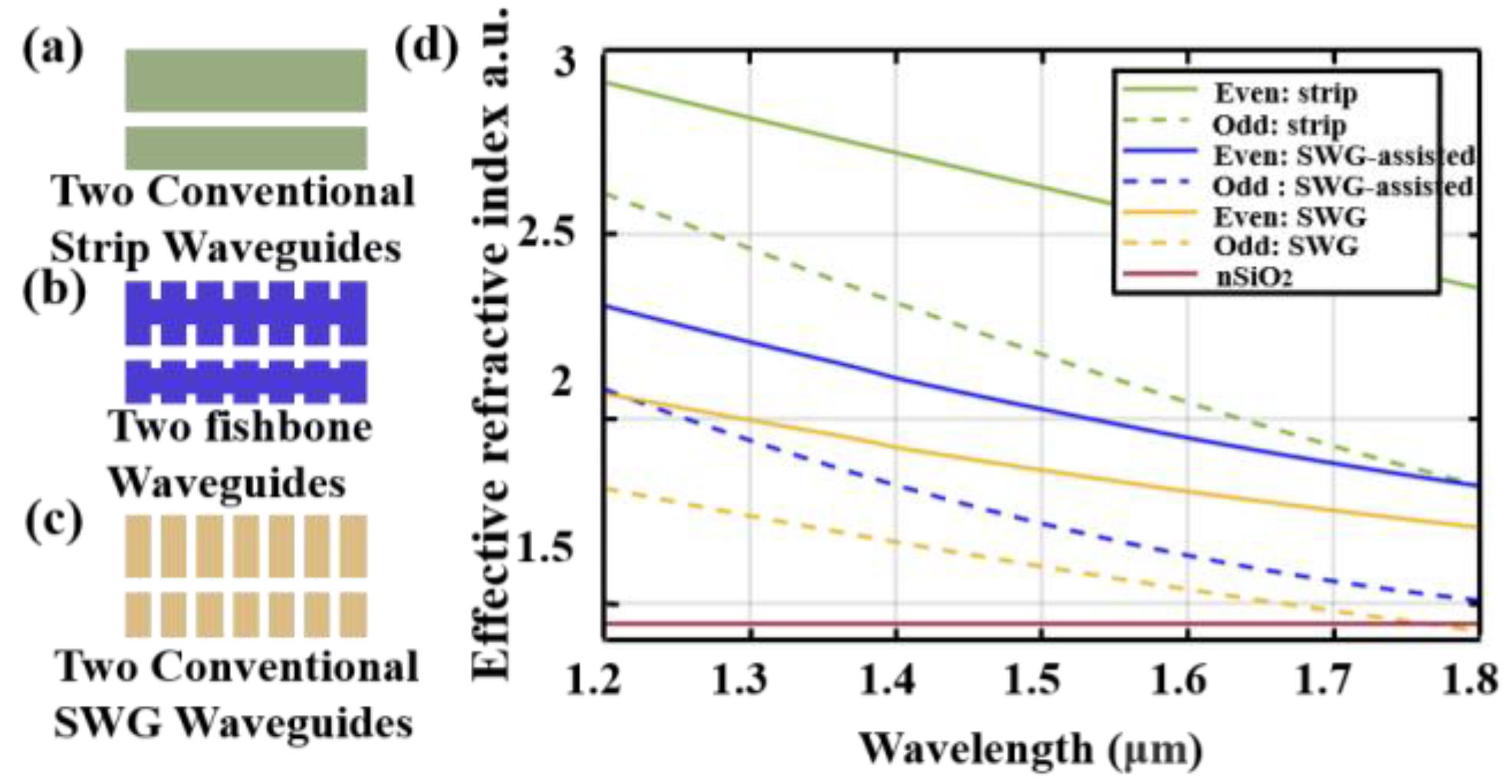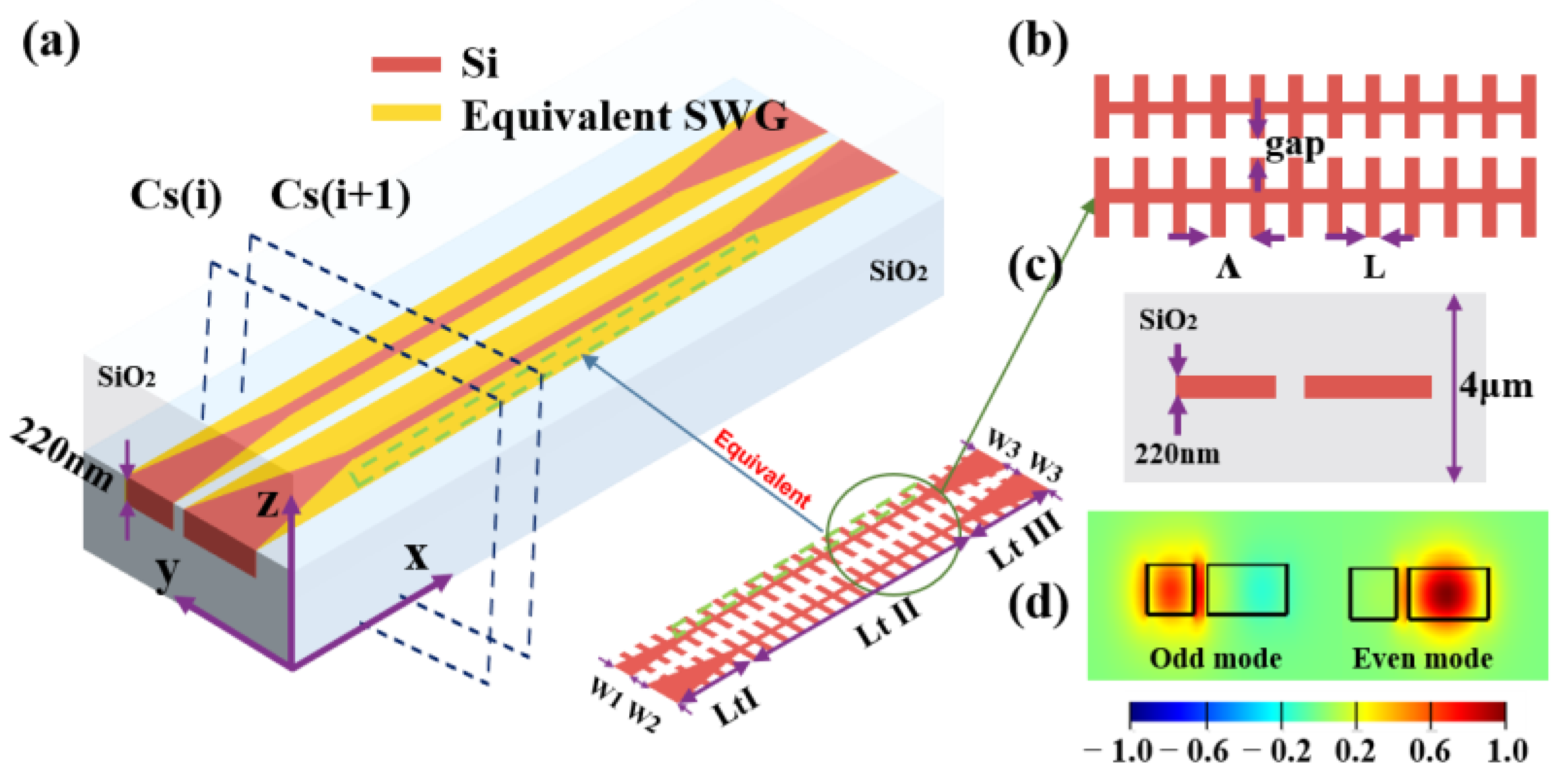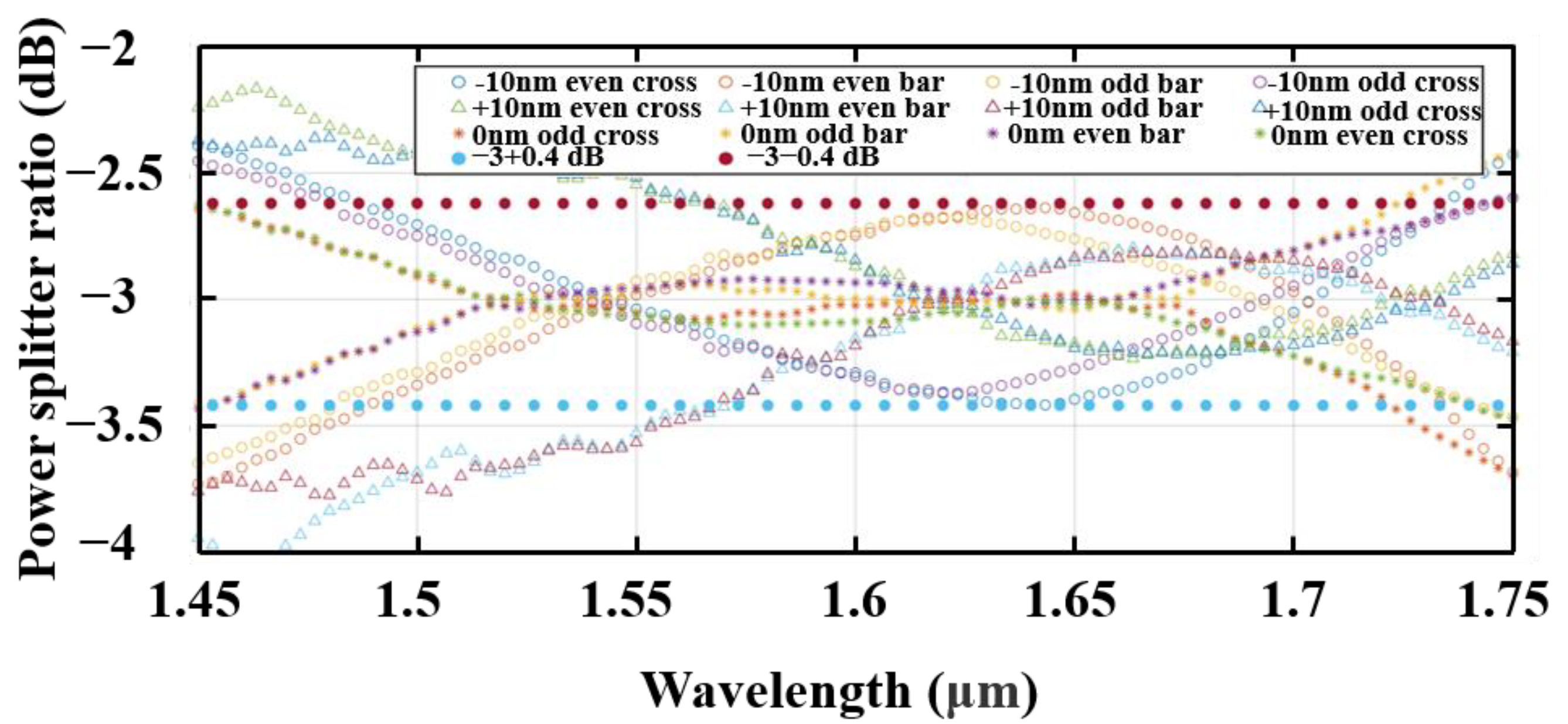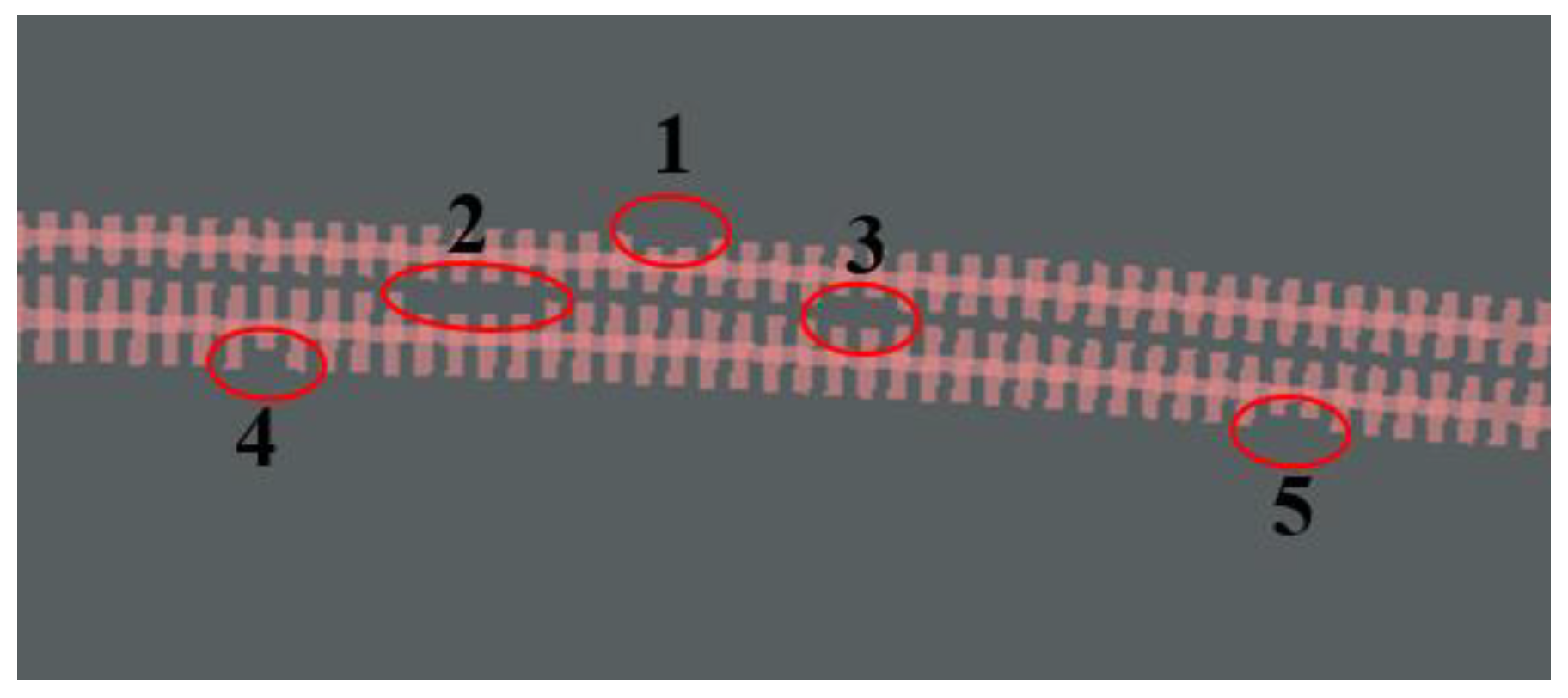Fast Adiabatic Mode Evolution Assisted 2 × 2 Broadband 3 dB Coupler Using Silicon-on-Insulator Fishbone-like Grating Waveguides
Abstract
:1. Introduction
2. Design Principles and Simulation
3. Results and Discussion
4. The Analysis about Device with Defects
5. Conclusions
Author Contributions
Funding
Data Availability Statement
Acknowledgments
Conflicts of Interest
References
- Soref, R. The Past, Present, and Future of Silicon Photonics. IEEE J. Sel. Top. Quantum Electron. 2006, 12, 1678–1687. [Google Scholar] [CrossRef]
- Subbaraman, H.; Xu, X.; Hosseini, A.; Zhang, X.; Zhang, Y.; Kwong, D.; Chen, R.T. Recent advances in silicon-based passive and active optical interconnects. Opt. Express 2015, 23, 2487–2511. [Google Scholar] [CrossRef] [PubMed]
- Thomson, D.; Zilkie, A.; Bowers, J.E.; Komljenovic, T.; Reed, G.T.; Vivien, L.; Marris-Morini, D.; Cassan, E.; Virot, L.; Fédéli, J.-M.; et al. Roadmap on silicon photonics. J. Opt. 2016, 18, 73003–73023. [Google Scholar] [CrossRef]
- Meng, Y.; Chen, Y.; Lu, L.; Ding, Y.; Cusano, A.; Fan, J.A.; Hu, Q.; Wang, K.; Xie, Z.; Liu, Z.; et al. Optical meta-waveguides for integrated photonics and beyond. Light Sci. Appl. 2021, 10, 235. [Google Scholar] [CrossRef] [PubMed]
- Meng, Y.; Feng, J.; Han, S.; Xu, Z.; Mao, W.; Zhang, T.; Kim, J.S.; Roh, I.; Zhao, Y.; Kim, D.-H.; et al. Photonic van der Waals integration from 2D materials to 3D nanomembranes. Nat. Rev. Mater. 2023, 8, 498–517. [Google Scholar] [CrossRef]
- Meng, Y.; Hu, F.; Liu, Z.; Xie, P.; Shen, Y.; Xiao, Q.; Fu, X.; Bae, S.H.; Gong, M. Chip-integrated metasurface for versatile and multi-wavelength control of light couplings with independent phase and arbitrary polarization. Opt. Express 2019, 27, 16425–16439. [Google Scholar] [CrossRef]
- Meng, Y.; Liu, Z.; Xie, Z.; Wang, R.; Qi, T.; Hu, F.; Kim, H.; Xiao, Q.; Fu, X.; Wu, Q.; et al. Versatile on-chip light coupling and (de)multiplexing from arbitrary polarizations to controlled waveguide modes using an integrated dielectric metasurface. Photonics Res. 2020, 8, 564–576. [Google Scholar] [CrossRef]
- Wang, X.; Xie, P.; Chen, B.; Zhang, X. Chip-Based High-Dimensional Optical Neural Network. Nanomicro Lett. 2022, 14, 221. [Google Scholar] [CrossRef]
- Xie, P.; Wang, X.; Wang, W.; Zhang, W.; Lu, Z.; Wang, Y.; Zhao, W. Rapid Repetition Rate Fluctuation Measurement of Soliton Crystals in a Microresonator. J. Vis. Exp. 2021, 178, e60689. [Google Scholar] [CrossRef]
- Dai, D.; Wang, S. Asymmetric directional couplers based on silicon nanophotonic waveguides and applications. Front. Optoelectron. 2016, 9, 450–465. [Google Scholar] [CrossRef]
- Xu, Y.; Tian, Z.; Meng, X.; Chai, Z. Methods and applications of on-chip beam splitting: A review. Front. Phys. 2022, 10, 985208. [Google Scholar] [CrossRef]
- Chen, G.F.R.; Ong, J.R.; Ang, T.Y.L.; Lim, S.T.; Png, C.E.; Tan, D.T.H. Broadband Silicon-On-Insulator directional couplers using a combination of straight and curved waveguide sections. Sci. Rep. 2017, 7, 7246–7253. [Google Scholar] [CrossRef]
- Chen, S.; Shi, Y.; He, S.; Dai, D. Low-loss and broadband 2 × 2 silicon thermo-optic Mach-Zehnder switch with bent directional couplers. Opt. Lett. 2016, 41, 836–839. [Google Scholar] [CrossRef] [PubMed]
- Maese-Novo, A.; Halir, R.; Romero-Garcia, S.; Perez-Galacho, D.; Zavargo-Peche, L.; Ortega-Monux, A.; Molina-Fernandez, I.; Wangueemert-Perez, J.G.; Cheben, P. Wavelength independent multimode interference coupler. Opt. Express 2013, 21, 7033–7040. [Google Scholar] [CrossRef] [PubMed]
- Lu, Z.; Yun, H.; Wang, Y.; Chen, Z.; Zhang, F.; Jaeger, N.A.; Chrostowski, L. Broadband silicon photonic directional coupler using asymmetric-waveguide based phase control. Opt. Express 2015, 23, 3795–3806. [Google Scholar] [CrossRef]
- Widhianto, B.Y.B.; Lu, Y.-T.; Chang, W.-C.; Hsu, S.-H. Broadband Coupler Manipulation through Particle Swarm Optimization for Arrayed Waveguide Grating Based Optical Coherence Tomography. IEEE Photonics J. 2021, 13, 1–13. [Google Scholar] [CrossRef]
- Menchon-Enrich, R.; Benseny, A.; Ahufinger, V.; Greentree, A.D.; Busch, T.; Mompart, J. Spatial adiabatic passage: A review of recent progress. Rep. Prog. Phys. 2016, 79, 74401. [Google Scholar] [CrossRef]
- Hung, Y.J.; Li, Z.Y.; Chung, H.C.; Liang, F.C.; Jung, M.Y.; Yen, T.H.; Tseng, S.Y. Mode-evolution-based silicon-on-insulator 3 dB coupler using fast quasiadiabatic dynamics. Opt. Lett. 2019, 44, 815–818. [Google Scholar] [CrossRef]
- Yun, H.; Chrostowski, L.; Jaeger, N.A.F. Ultra-broadband 2 × 2 adiabatic 3 dB coupler using subwavelength-grating-assisted silicon-on-insulator strip waveguides. Opt. Lett. 2018, 43, 1935–1938. [Google Scholar] [CrossRef]
- Yun, H.; Wang, Y.; Zhang, F.; Lu, Z.; Lin, S.; Chrostowski, L.; Jaeger, N.A. Broadband 2 × 2 adiabatic 3 dB coupler using silicon-on-insulator sub-wavelength grating waveguides. Opt. Lett. 2016, 41, 3041–3044. [Google Scholar] [CrossRef]
- Cabanillas, J.M.F.; Popovic, M.A. Fast adiabatic mode evolution based on geometry-induced suppression of nearest-mode crosstalk. In Proceedings of the 2018 Conference On Lasers and Electro-Optics (Cleo), San Diego, CA, USA, 13–18 May 2018. [Google Scholar] [CrossRef]
- Cabanillas, J.M.F.; Onural, D.; Popović, M.A. Rapid Adiabatic 3 dB Coupler with 50 ± 1% Splitting Over 200 nm including S, C and L Bands in 45 nm CMOS Platform. In Proceedings of the Frontiers in Optics 2021, Washington, DC, USA, 1–4 November 2021; p. FTu6B.2. [Google Scholar] [CrossRef]
- Cabanillas, J.M.F.; Zhang, B.; Popović, M.A. Demonstration of 3 ± 0.12 dB Power Splitting over 145 nm Optical Bandwidth in a 31-μm Long 3-dB Rapid Adiabatic Coupler. In Proceedings of the Optical Fiber Communication Conference, San Diego, CA, USA, 8–12 March 2020; p. Th1A.2. [Google Scholar] [CrossRef]
- Halir, R.; Cheben, P.; Luque-González, J.M.; Sarmiento-Merenguel, J.D.; Schmid, J.H.; Wangüemert-Pérez, G.; Xu, D.-X.; Wang, S.; Ortega-Moñux, A.; Molina-Fernández, Í. Waveguide sub-wavelength structures: A review of principles and applications. Laser Photonics Rev. 2015, 9, 25–49. [Google Scholar] [CrossRef]
- Sun, L.; Zhang, Y.; He, Y.; Wang, H.; Su, Y. Subwavelength structured silicon waveguides and photonic devices. Nanophotonics 2020, 9, 1321–1340. [Google Scholar] [CrossRef]
- Rytov, S. Electromagnetic properties of a finely stratified medium. Sov. Phys. JEPT 1956, 2, 466–475. [Google Scholar]
- Lalanne, P.; Lemercier-lalanne, D. On the effective medium theory of subwavelength periodic structures. J. Mod. Opt. 1996, 43, 2063–2085. [Google Scholar] [CrossRef]
- Lalanne, P.; Hugonin, J.-P. High-order effective-medium theory of subwavelength gratings in classical mounting: Application to volume holograms. J. Opt. Soc. Am. A 1998, 15, 1843–1851. [Google Scholar] [CrossRef]
- Snyder, A.W.; Love, J. Optical Waveguide Theory; Springer: Berlin/Heidelberg, Germany, 1983. [Google Scholar]
- Palik, E.; Glembocki, O.; Stahlbush, R. Fabrication and Characterization of Si Membranes. J. Electrochem. Soc. 1988, 135, 3126–3134. [Google Scholar] [CrossRef]
- Oskooi, A.F.; Roundy, D.; Ibanescu, M.; Bermel, P.; Joannopoulos, J.D.; Johnson, S.G. Meep: A flexible free-software package for electromagnetic simulations by the FDTD method. Comput. Phys. Commun. 2010, 181, 687–702. [Google Scholar] [CrossRef]
- Wang, Y.; Lu, Z.; Ma, M.; Yun, H.; Zhang, F.; Jaeger, N.A.F.; Chrostowski, L. Compact Broadband Directional Couplers Using Subwavelength Gratings. IEEE Photonics J. 2016, 8, 7101408. [Google Scholar] [CrossRef]
- Halir, R.; Maese-Novo, A.; Ortega-Monux, A.; Molina-Fernandez, I.; Wangueemert-Perez, J.G.; Cheben, P.; Xu, D.-X.; Schmid, J.H.; Janz, S. Colorless directional coupler with dispersion engineered sub-wavelength structure. Opt. Express 2012, 20, 13470–13477. [Google Scholar] [CrossRef]
- Xu, L.; Wang, Y.; Kumar, A.; El-Fiky, E.; Mao, D.; Tamazin, H.; Jacques, M.; Xing, Z.; Saber, G.; Plant, D.V. Compact high-performance adiabatic 3-dB coupler enabled by subwavelength grating slot in the silicon-on-insulator platform. Opt. Express 2018, 26, 29873–29885. [Google Scholar] [CrossRef]
- Lu, Z.; Jhoja, J.; Klein, J.; Wang, X.; Liu, A.; Flueckiger, J.; Pond, J.; Chrostowski, L. Performance prediction for silicon photonics integrated circuits with layout-dependent correlated manufacturing variability. Opt. Express 2017, 25, 9712–9733. [Google Scholar] [CrossRef] [PubMed]
- Brunetti, G.; Marocco, G.; Benedetto, A.D.; Giorgio, A.; Armenise, M.N.; Ciminelli, C. Design of a large bandwidth 2 × 2 interferometric switching cell based on a sub-wavelength grating. J. Opt. 2021, 23, 85801. [Google Scholar] [CrossRef]
- DasMahapatra, P.; Stabile, R.; Rohit, A.; Williams, K.A. Optical Crosspoint Matrix Using Broadband Resonant Switches. IEEE J. Sel. Top. Quantum Electron. 2014, 20, 5900410. [Google Scholar] [CrossRef]
- Kumar, S.; Raghuwanshi, S.K.; Kumar, A. Implementation of optical switches using Mach–Zehnder interferometer. Opt. Eng. 2013, 52, 97106. [Google Scholar] [CrossRef]
- Yang, H.; Kuan, Y.; Xiang, T.; Zhu, Y.; Cai, X.; Liu, L. Broadband polarization-insensitive optical switch on silicon-on-insulator platform. Opt. Express 2018, 26, 14340–14345. [Google Scholar] [CrossRef] [PubMed]
- Dano, L.D.; Lee, S.L.; Fang, W.H. Compact and Broadband Asymmetric Curved Directional Couplers Using the Silicon-On-Insulator (SOI) Platform. In Proceedings of the 2019 24th Optoelectronics And Communications Conference (Oecc) And 2019 International Conference On Photonics In Switching And Computing (Psc), Fukuoka, Japan, 7–11 July 2019. [Google Scholar] [CrossRef]
- Morino, H.; Maruyama, T.; Iiyama, K. Reduction of Wavelength Dependence of Coupling Characteristics Using Si Optical Waveguide Curved Directional Coupler. J. Light. Technol. 2014, 32, 2188–2192. [Google Scholar] [CrossRef]
- Lee, T.; Lee, D.; Chung, Y. Design and Simulation of Fabrication-Error-Tolerant Triplexer Based on Cascaded Mach–Zehnder Inteferometers. IEEE Photonics Technol. Lett. 2008, 20, 33–35. [Google Scholar] [CrossRef]










| Parameters | W1 | W2 | W3 | Wcore | LtI | LtII | LtIII | Gap | Λ | L |
|---|---|---|---|---|---|---|---|---|---|---|
| unit/μm | 0.35 | 0.61 | 0.48 | 0.12 | 15 | 9 | 15 | 0.1 | 0.2 | 0.1 |
| The splitting ratio is unified to 3 ± 0.1 dB | 7 | 10 | [36] | Subwavelength coupler |
| 27 | 8 | [37] | Directional coupler | |
| 3250 | 15 | [38] | Directional coupler | |
| 16 | 80 | [39] | Adiabatic coupler | |
| 13 | 20 | [13] | Bent directional couplers | |
| 7 | 42 | [40] | Curved directional couplers | |
| 7 | 46 | [41] | Curved directional coupler | |
| 34 | 21 | [42] | Directional coupler | |
| 19 | 20 | [33] | Subwavelength coupler | |
| 23 | 30 | [14] | Multimode interference coupler | |
| 9 | 168 | Our work | Fishbone-like fast adiabatic coupler |
| The splitting ratio is unified to 3 ± 0.1 dB | 10 | 167/167 | 0.052/0.561 | 170/176 | 0.052/0.592 |
| 20 | 160/166 | 0.053/0.591 | 153/160 | 0.053/0.596 | |
| 30 | 156/163 | 0.054/0.587 | 133/130 | 0.054/0.600 | |
| 40 | 140/140 | 0.055/0.561 | 103/53 | 0.056/0.608 | |
| 50 | 127/123 | 0.057/0.562 | 67/27 | 0.056/0.623 | |
| 60 | 113/113 | 0.058/0.564 | ~ | ||
| 70 | 107/60 | 0.060/0.565 | ~ | ~ | |
| 80 | 100/57 | 0.061/0.569 | ~ | ~ |
Disclaimer/Publisher’s Note: The statements, opinions and data contained in all publications are solely those of the individual author(s) and contributor(s) and not of MDPI and/or the editor(s). MDPI and/or the editor(s) disclaim responsibility for any injury to people or property resulting from any ideas, methods, instructions or products referred to in the content. |
© 2023 by the authors. Licensee MDPI, Basel, Switzerland. This article is an open access article distributed under the terms and conditions of the Creative Commons Attribution (CC BY) license (https://creativecommons.org/licenses/by/4.0/).
Share and Cite
Xue, Y.; Zhang, L.; Ren, Y.; Lei, Y.; Sun, X. Fast Adiabatic Mode Evolution Assisted 2 × 2 Broadband 3 dB Coupler Using Silicon-on-Insulator Fishbone-like Grating Waveguides. Nanomaterials 2023, 13, 2776. https://doi.org/10.3390/nano13202776
Xue Y, Zhang L, Ren Y, Lei Y, Sun X. Fast Adiabatic Mode Evolution Assisted 2 × 2 Broadband 3 dB Coupler Using Silicon-on-Insulator Fishbone-like Grating Waveguides. Nanomaterials. 2023; 13(20):2776. https://doi.org/10.3390/nano13202776
Chicago/Turabian StyleXue, Yulong, Lingxuan Zhang, Yangming Ren, Yufang Lei, and Xiaochen Sun. 2023. "Fast Adiabatic Mode Evolution Assisted 2 × 2 Broadband 3 dB Coupler Using Silicon-on-Insulator Fishbone-like Grating Waveguides" Nanomaterials 13, no. 20: 2776. https://doi.org/10.3390/nano13202776





